|
abot87-3
|
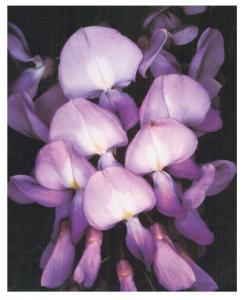
|
Flowers of Wisteria floribunda, a well-known ornamental plant from East Asia. Wisteria has been placed in the predominantly tropical tribe Millettieae by its morphological similarities. However, molecular evidence suggests that Wisteria and a tropical genus Callerya are closer to many temperate herbaceous legumes but not to other Millettieae members.
|
copyright: BSA,
license: http://images.botany.org/index.html#license |
Image
|
Systematics

|

|
|
abot87-4
|
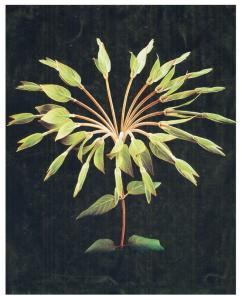
|
Sixteen photographs of a single shoot of the vine Lonicera japonica are superimposed to create a time-lapse image of its clockwise rotation. The photographs were taken over a 2-h period and represent the plant movement known as circumnutation.
|
copyright: BSA,
license: http://images.botany.org/index.html#license |
Image
|
Ecology

|

|
|
abot87-5
|

|
A site on Stepping Stones Island along the west coast of the Antarctic Peninsula where plants were collected for field and environmental chamber experiments examining the influence of temperature on the growth of flowering plants.
|
copyright: BSA,
license: http://images.botany.org/index.html#license |
Image
|
Ecology

|

|
|
abot87-6
|
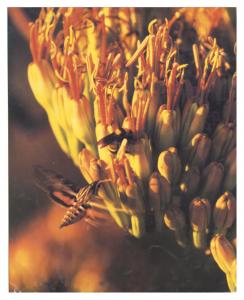
|
White-lined moth (Hyles lineata) and bumble bee (Bombus pennsylvanicus sonorus) foraging on Agave palmeri in a wild population near Fort Huachuca, Arizona.
|
copyright: BSA,
license: http://images.botany.org/index.html#license |
Image
|
Reproductive Biology

|

|
|
abot87-7
|

|
Flower of Nasa urensfrom the genus Nasa (Loasaceae), a taxon that contains only iridoids that are widespread in the family.
|
copyright: BSA,
license: http://images.botany.org/index.html#license |
Image
|
Systematics

|

|
|
abot87-8
|
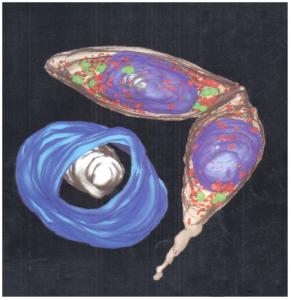
|
Computer-generated three-dimensional reconstruction of the male germ unit of rye (Secale cereale) based upon serial ultrathin sections. The two elongated sperm cells are connected at one end and each contains some plastids (green), as well as numerous mitochondria (red) and a nucleus (blue). The vegetative nucleus (blue) is closely associated with the sperm cells, but not connected; it contains a single nucleolus (white).
|
copyright: BSA,
license: http://images.botany.org/index.html#license |
Image
|
Reproductive Biology

|

|
|
abot87-9
|
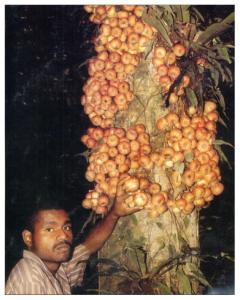
|
Cauliflorous figs of Ficus itoana from Madang, Papua, New Guinea. This species is functionally dioecious due to the interaction of the pollinating fig wasp Ceratosolen armipes,with two types of figs on separate plants. Functionally dioecious figs in subgenus Ficus have been found to be nonmonophyletic.
|
copyright: BSA,
license: http://images.botany.org/index.html#license |
Image
|
Systematics

|

|
|
abot88-1
|
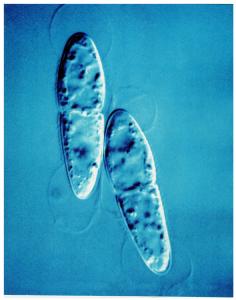
|
Artificially colored ascospores of the saprobic microfungus Aliquandostipite khaoyaiensis(Loculoascomycetes, Ascomycota). The ascospores are hyaline, ~60 µm long, and surrounded by an appressed sheath that detaches when it comes in contact with water. The fungus is thus far known only from the type locality in a tropical rain forest in Thailand. Fruitbodies are ~0.25 mm across, light to dark yellow in color, and formed on decaying wood on the ground. Partly because of their small size, saprobic microfungi are poorly known. Surveys, especially in the tropics, regularly yield high proportions of new species, of which many are difficult to place in the existing taxonomic system, even at the ordinal level.
|
copyright: BSA,
license: http://images.botany.org/index.html#license |
Image
|
Mycology and Plant Pathology

|

|
|
abot88-10
|
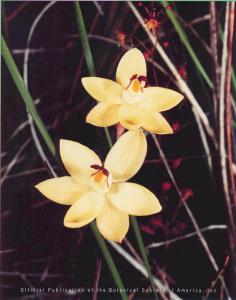
|
Lemon-scented sun orchid, Thelymitra antennifera. Members of Thelymitrinae rely on deceit to attract pollinators. This species blooms at the same time as a similar lilioid flower that offers a reward. The generalized floral morphology seen in Thelymitra probably represents the plesiomorphic state for Diurideae, but members of the subtribe often have highly modified columns adorned with brush-like appendages to assist in pollen presentation, a simple form of which can be seen in this species.
|
copyright: BSA,
license: http://images.botany.org/index.html#license |
Image
|
Systematics

|

|
|
abot88-11
|
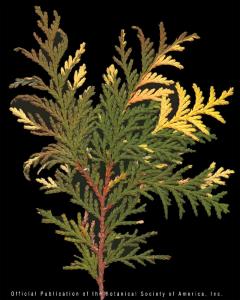
|
Chimeric branches of the sawara false cypress, Chamaecyparis pisifera `nana aureovariegata' collected at Bernheim Forest, Clermont, Kentucky. Albino mutant sectors give rise irreversibly to completely albino branches, suggesting a single cell is the fount of all cells of a shoot.
|
copyright: BSA,
license: http://images.botany.org/index.html#license |
Image
|
Development and Morphogenesis

|

|
|
abot88-12
|
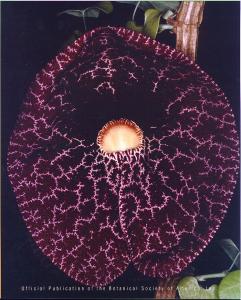
|
Aristolochia gigantea. Although the flowers of Aristolochia are highly specialized whereas those of Lactoris are less complex, recent phylogenetic analyses based on molecular data suggest an unexpectedly close relationship between the two genera. Stipule ontogeny and morphology are essentially the same in Piperaceae, Saururaceae, and Lactoris, while inflorescence morphology is very similar in Lactoris and Aristolochiaceae. See Gonzalez and Rudall: The questionable affinities of Lactoris: evidence from branching pattern, inflorescence morphology, and stipule development, pp. 2143-2150 in thisissue.
|
copyright: BSA,
license: http://images.botany.org/index.html#license |
Image
|
Anatomy and Morphology

|

|
|
abot88-2
|

|
The sunflower species Helianthus anomalus from the Little Sahara Sand Dunes in Utah.
|
copyright: BSA,
license: http://images.botany.org/index.html#license |
Image
|
Population Biology

|

|
|
abot88-3
|
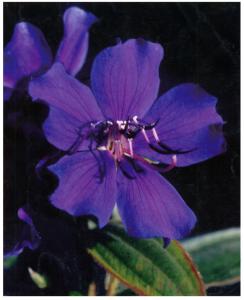
|
A flower of Tibouchina semidecandra, a well-known ornamental from southeastern Brazil. Tibouchinais a member of the large tropical family Melastomataceae and together with other Melastomeae has been regarded as representing a relatively basal element of the family. Molecular evidence suggests that Tibouchina, Melastoma, Osbeckia, and other Melastomeae represent a derived clade of Melastomataceae that only recently reached Africa and tropical Asia.
|
copyright: BSA,
license: http://images.botany.org/index.html#license |
Image
|
Systematics

|

|
|
abot88-4
|
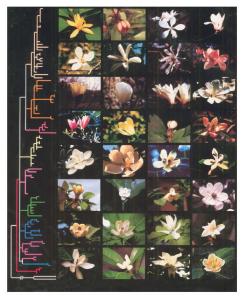
|
The magnificent blossoms of magnolias have been highly prized in landscaping for centuries. Molecular analysis of the magnolia family provides new evidence for phylogenetic relationships previously undetected by systematists. From top left: Michelia champaca; Mich. figo; Mich. maudiae; Magnolia biondii; Mag. zenii; Mag. kobus; Mag. stellata; Mag. campbellii; Mag. sprengeri; Mag. denudata; Mag. cylindrica; Mag. salicifolia; Mag. lilliflora; Mag. acuminata; Manglietia moto; Mang. insignis; Mag. grandiflora; Mag. sharpii; Mag. virginiana; Mag. henryi; Mag. delavayi; Mag. coco; Mag. sieboldii; Mag. wilsonii; Mag. obovata; Mag. officinalis; Mag. tripetala; Mag. splendens; Mag. fraseri; Kmeria septentrionalis; Mag. macrophylla; Liriodendron tulipifera. Photo credit: Sangtae Kim, Richard Figlar, Dorothy Callaway, Munyong Chong, Kihun Song, Holly Forbes, Kenneth Durio, and Junghee Lee. Design: Sangtae Kim.
|
copyright: BSA,
license: http://images.botany.org/index.html#license |
Image
|
Systematics

|

|
|
abot88-5
|
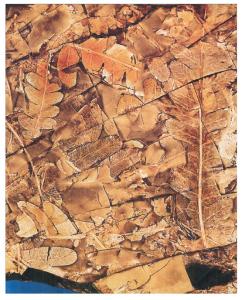
|
Fossil Woodwardia virginica foliage from the middle Miocene Yakima Canyon flora of central Washington State, USA. Vegetative and fertile features of this fossil are remarkably similar to those of the modern "Virginia chain fern" of the Atlantic coastal region, USA.
|
copyright: BSA,
license: http://images.botany.org/index.html#license |
Image
|
Unclassified

|

|
|
abot88-6
|
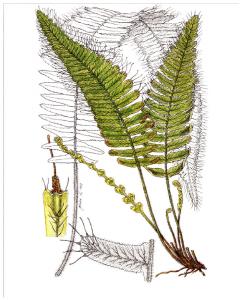
|
A watercolor reproduction of Plate 27, Trichomanes crispum, originally drawn by Walter Fitch for Hooker, W. J. 1862. Garden ferns. Lovell, Reeve & Co., London, UK.
|
copyright: BSA,
license: http://images.botany.org/index.html#license |
Image
|
Systematics

|

|
|
abot88-7
|
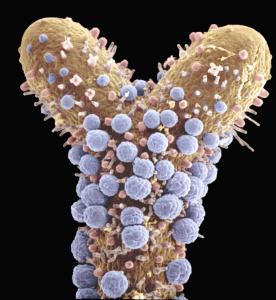
|
Scanning electron micrograph of dichotomously branched, subterranean gametophyte of Psilotum nudum grown in axenic culture. Antheridia are falsely colored blue, archegonia are salmon colored, and hairs and rhizoids are brown.
|
copyright: BSA,
license: http://images.botany.org/index.html#license |
Image
|
Structure and Development

|

|
|
abot88-8
|
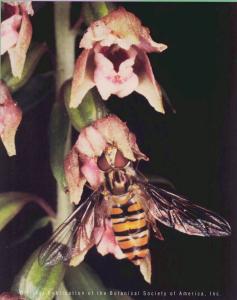
|
A hover-fly transports pollinia among flowers of Epipactis helleborine (L.) Crantz in England. Dominantly wasp-mediated cross-pollination has generated genetic structures consistent with random mating in both European and introduced North American populations.
|
copyright: BSA,
license: http://images.botany.org/index.html#license |
Image
|
Population Biology

|

|
|
abot88-9
|
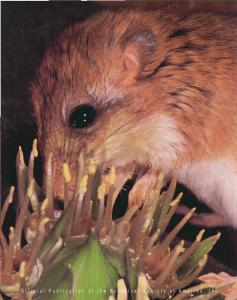
|
A nocturnal rodent, Gerbilluris paeba, feeds on the copious amounts of jelly-like nectar produced by flowers of the African lily Massonia depressa (Hyacinthaceae). This lily, which has flowers situated at ground level, is the first monocotyledon discovered to be pollinated by rodents. The striking similarities between the flowers of M. depressa and those of unrelated rodent-pollinated Protea spp. (Proteaceae) provide strong support for the concept of convergent floral syndromes.
|
copyright: BSA,
license: http://images.botany.org/index.html#license |
Image
|
Reproductive Biology

|

|
|
abot89-1
|

|
Fire rages through oaks, pines, and palmettos at the Archbold Biological Station, Lake Placid, Florida. Scrub oaks quickly regain acorn production following fire.
|
copyright: BSA,
license: http://images.botany.org/index.html#license |
Image
|
Ecology

|

|